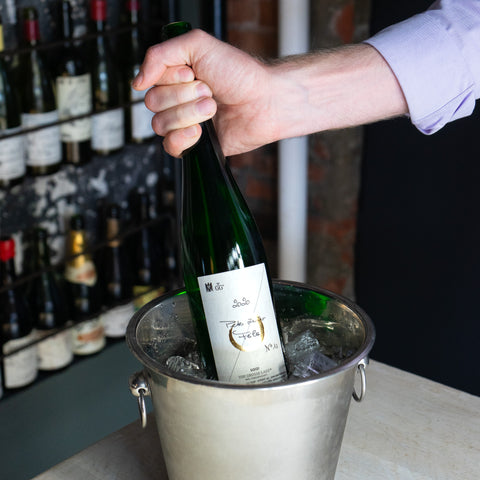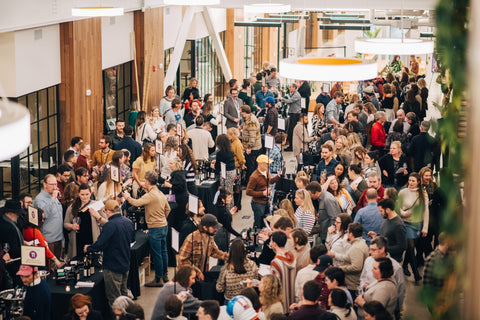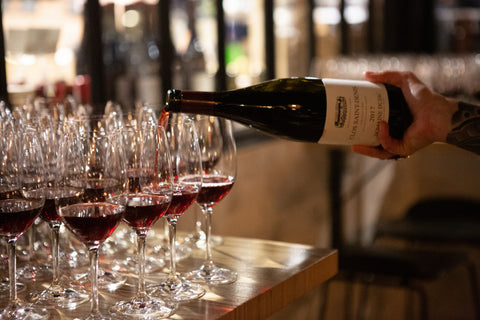“I don’t like sweet wine.”
It’s so easy to say that, whether it’s about Riesling, country music, or low-rise jeans. When a big story leaves a bad taste in the collective cultural mouth, it's easy for us to dislike it unconditionally.
That’s what happened to Riesling. In the late 20th century, there was a boom of mass-produced, sickly sweet German Riesling. And people got sick of it. The thing is, that’s not the Riesling we know.
Good German Riesling is a wine with as much history, depth, and dimension as good Burgundy. It can be immediate and refreshing, and it can age for years. It can be bone dry or honey-sweet, but will always send a shiver down your spine with its rippling acidity and explosive aromatics. There is really good sweet Riesling out there, and amazing dry Riesling.
Serious wine nerds know this, and public perception is slowly changing, but we have a long way to go.
If you’re ready to discover what great Riesling is all about, read on and learn about the regions, terms to look out for on the label, and what we pair with Riesling.
The Important Regions
Mosel
This is the farthest north that Riesling can ripen. The region follows the River Mosel, and vineyards cling to the steep banks that rise from the path it’s carved through the landscape. You’ll find bone-dry Riesling, but increasingly we’re seeing more racy, exciting off-dry styles.
Nahe
The Rieslings of the Nahe have more body than those from the Mosel but can age for just as long. You’ll find some of the most beautiful dry German Rieslings here.
Rheingau
The most historic, and smallest, German wine region. This is the birthplace of Riesling. The most expensive wines here are the sweet Beerenauslesen and Trockenbeerenauslesen wines, but they make up just 20% of the total production — the rest is dry.
Rheinhessen
The Rheinhessen is one of the most innovative wine regions in Germany. It’s the largest region, and wasn’t always taken as seriously as the Mosel or Nahe. Riesling now makes up most of the production, but the region also grows Müller-Thurgau, Dornfelder and Silvaner.
Pfalz
Pfalz is sunnier and warmer than its northern neighbors and sits on the eastern side of the Vosges, and as a result the wines are richer and riper. You’ll find innovative winemakers working with many different grape varieties, but Riesling is still the most common.
The Terms to Know
Deciphering a German wine label can be confusing. But learning the Prädikatswein — the system for qualifying some of the best Rieslings — can help. For a Riesling to be labeled Prädikatswein, it must meet strict criteria. The wines are qualified by ripeness level, and go from sweetest to driest:
- Trockenbeerenauslese
- Eiswein
- Beerenauslese
- Auslese
- Spätlese
- Kabinett.
Are you looking for a dry Riesling? Look for the term trocken, which means dry. You can also find delicious off-dry wines labeled halbtrocken or feinherb.

How to Pair Riesling
Riesling is amazing at the table. It's high acidity makes it a perfect karate chop through rich dishes. Whether it's a light-as-air citrus and mineral-driven Riesling from the Mosel or a more full-bodied, rounder fruited Riesling from Pfalz, you'll find excellent combinations at the table. Pair a dry Riesling with rich and crunchy schnitzels, juicy seared pork, seafood, and chicken in creamy sauces.
When it comes to off-dry or medium Rieslings, go for spicy dishes. Sweetness balances fiery spice perfectly. A go-to is Thai or Chinese food. We always have a bottle of feinherb or Spätlese on hand for spicy Thai dishes like crispy duck salads or Pad Kee Mao.



